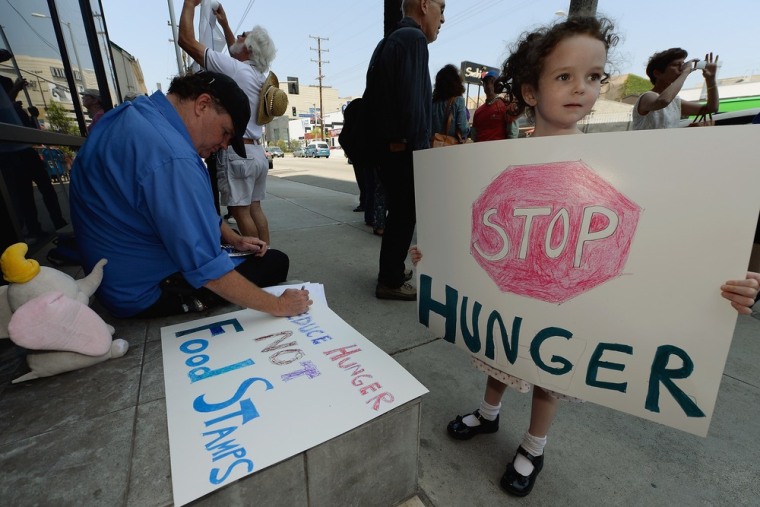
For one in seven Americans, the federal government’s Supplemental Nutrition Assistance Program, aka food stamps, is all that stands between them and too little food.
But the complicated calculus of financial survival for the working poor also means any cuts to the roughly $80 billion SNAP, as it’s known, being considered by Congress would be felt well beyond the grocery checkout line. Buying new school clothes, family outings, even getting a toehold in the financial mainstream could be thrown into limbo.
For many of the working poor, wages just don’t go far enough. The National Employment Law project says nearly 60 percent of jobs created in the post-recession recovery pay $13.83 or less an hour, and hourly wages for some low-wage occupations fell by more than 5 percent in just three years.
Food service and temporary employment make up 43 percent of the post-recession job growth, according to NELP policy analyst Jack Temple. "They overwhelmingly pay low wages,” Temple said. “For that lower segment, you’re going to see increased use of safety net programs to make up the difference."
Sharonton Taylor of Marietta, Ga., is a single mom of three, even working full-time and earning $9.50 an hour as a certified nurse's aide qualifies her for $500 a month in food stamps. (Like Medicaid, SNAP is federally funded but administered at the state level.) That’s still about $150 less than the U.S.D.A.'s average monthly estimate of what a “low-cost food plan” should cost for Taylor’s family.
If that $500 were cut, Taylor wouldn’t be able to buy new clothes for her daughter and two sons, or take them on the kind of outings middle-class kids take for granted. “We’d play Uno or do something around the house, try to make it fun for them, instead of going to the zoo, to the aquarium, stuff like that,” she said.
Taylor said it’s hard trying to explain to her kids, who are eight, five and four, about the family’s dire financial straits. “I have to tell them, ‘Mom don’t have it right now. Don’t you want a roof over your head?’... I have to keep telling them that.”
Buying less food
The next step would be simply buying less food, she said. As it is, Taylor says she often struggles to make it until the 9th day of each month, when her SNAP card is refilled. “I’ll try to make the food last… It feels hard to stretch, especially if you cook everyday. I get low at the end of the month and I have another week to go.” During that week, cheap, filling staples like spaghetti fill the gap.
“As finances get worse, the dietary quality also gets worse,” warned Dr. Deborah Frank, founder and principal investigator of Children's HealthWatch at the Boston University-affiliated Boston Medical Center. “Poor nutrition isn’t obvious to the lay person,” she said. “This is a health problem. I think that’s the connection that people miss.”
But there are sharp disagreements in Washington about how to fix the system. Proponents of cutting SNAP funding say the program is bloated, poorly managed and subject to abuse.
"There are 21 programs that provide food-purchasing assistance at the federal level. Isolating SNAP is distorting the debate," said Michael Tanner, a senior fellow at the Cato Institute. " We spend too much on the social welfare safety net for too little gain."
Calling SNAP "the fastest-growing welfare program that we have," Tanner said even cuts of nearly $21 billion over the next 10 years proposed by the Republican-led House of Representatives don't go far enough.

Kevin Concannon, undersecretary for food, nutrition and consumer services at the U.S. Department of Agriculture, countered that the program’s growth was a necessary response to the recession and unemployment it produced. “Most of the increase in SNAP is attributable to the depth and severity of the economic downturn,” he said.
Anti-hunger advocates say the program has become a political football. “A lot of the racial and gender and other cultural politics of the country play out through the food stamp program,” said Jim Weill, president of the Food Research and Action Center. “They shouldn’t, but they do.”
On Thursday, the House voted to decouple food stamps from a five-year farm bill, setting the stage for a battle with the Democratic-led Senate and the White House. But whichever party wins, the real losers will be families who have benefits cut or eliminated, said Lisa Davis, senior vice president of government relations at nonprofit Feeding America.
Other proposed changes to SNAP would have longer-term ramifications for people struggling to lift their families out of poverty.
Juggling jobs
Krystal Cole juggles two jobs in pursuit of that goal. A single mother of two in Marietta, Ga., Cole works Monday through Friday in an on-the-job training internship that pays roughly minimum wage for 20 of the 40 hours she works. On weekends, she works as a waitress for two seven-hour shifts at a waffle restaurant. Nearly all of that paycheck goes toward her health insurance; virtually her only take-home pay on weekends is the roughly $100 she pulls down in tips.
"I work hard but I still don’t make enough money," Cole said. "Food is expensive, and you don't really realize it until you have all these mouths to feed." Cole gets $160 a month in SNAP benefits, and estimates that she pays another $100 or so out of pocket each month (her kids are in programs that give them breakfast and lunch on weekdays).
In one sense, though, Cole is lucky. Feeding America says the average SNAP household has only $333 in assets. The Center for Family Resources in Marietta helped Cole set up a savings account about a year and a half ago and taught her the importance of budgeting and saving. She's been socking away a little bit — $20 here, $50 there on a good week — ever since.
Currently, the government lets states lift a $2,000 asset cap on SNAP participation so families aren’t forced to wipe out their savings before becoming eligible. But changes proposed under the House’s original farm bill would take away that option. If Cole’s eligibility for food stamps were at risk because of her small nest egg, she would face a difficult decision: benefits now, or a more secure financial future.
Farm bill aside, food stamp benefits are going to drop by an average of $20 to $25 per family in November anyway when a stimulus increase expires, Davis said. The U.S.D.A. estimated that last year's drought will make food prices rise up to 3.5 percent over the course of the year.
Families are already feeling the pinch. “I’m barely making it, even with the program,” said Michelle Tyson, a school bus aide and single mother to three teenaged boys in Buffalo, N.Y., who gets nearly $400 a month in food stamps despite working 30 hours a week and taking every extra shift that comes her way.
If her benefits were cut back, “There would be no more cookies or chips, I tell you that. I don't buy a lot of it, but I buy enough that it could be cut back.” Next, Tyson said she would start rationing. “I would cut out portions… It's no fun not being able to eat what you want to eat or not having any food in the house,” she said.